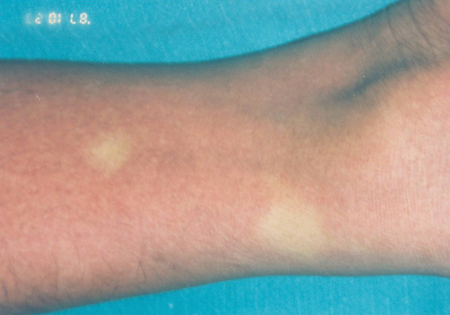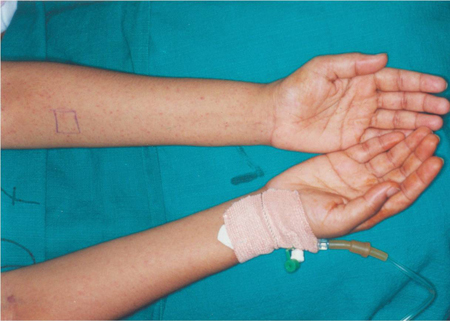History and exam
Key diagnostic factors
common
fever
Fever is the hallmark of infection and is usually abrupt in onset.
Very often it has an abrupt onset with very high spikes of 103°F to 105°F. It may also be biphasic and have a remittent pattern or be low grade.
Generally, lasts approximately 5 to 7 days and may cause febrile seizures or delirium in young children.
Rapid defervescence may indicate a patient with dengue infection is about to enter the critical phase of infection.[2][15]
skin flushing/rash
Diffuse skin flushing of the face, neck, and chest develop early on in the infection.[Figure caption and citation for the preceding image starts]: Typical skin flushing with islands of normal skin in patient with dengue feverFrom the collection of Professor S.A.M. Kularatne [Citation ends].
This evolves into a maculopapular or rubelliform rash involving the whole body, usually on the third or fourth day of the fever. The flushing may blanch when the affected skin is pressed.[72]
The rash fades with time and appears as islands of pallid areas during the convalescent phase.
May not be seen, may be difficult to see, or may look different in people with black skin.
myalgia/arthralgia/headache
Backache, arthralgia, myalgia, and bone pain is common.
Headache is also common and is usually constant and toward the front of the head. It usually improves within a few days.
Severe retro-orbital pain on eye movement or with little pressure applied to the eyeball is also common.
uncommon
hemorrhagic signs
More common in dengue hemorrhagic fever (DHF).
Include petechiae, purpura, or a positive tourniquet test.[Figure caption and citation for the preceding image starts]: Positive tourniquet test showing presence of rubelliform rash and petechiaeFrom the collection of Professor S.A.M. Kularatne [Citation ends].
May manifest as epistaxis, gingival bleeding, hematemesis, melena, vaginal bleeding (in women of childbearing age), or bleeding from a venipuncture site.
These signs can occur with either dengue fever or DHF, although they are uncommon in DF, so the stage of infection should be differentiated.[1][2]
Mucosal bleeding is a warning sign that indicates a patient with dengue infection is about to enter the critical phase of infection.[2][15]
lethargy/restlessness
hepatomegaly
abdominal distention
pleuritic chest pain, dyspnea, cough
signs of circulatory collapse
Indicates the presence of shock and is diagnostic for dengue shock syndrome (DSS).[1][2]
Signs include cold clammy skin, rapid and weak pulse with narrowing of pulse pressure <20 mmHg with decreased diastolic pressure, postural drop of blood pressure >20 mmHg, capillary refill time >3 seconds, and reduced urine output.
Other diagnostic factors
common
gastrointestinal symptoms
Anorexia, nausea/vomiting, epigastric discomfort/pain, lack of appetite, and/or changes to taste sensation may be present.
Abdominal pain and tenderness or persistent vomiting are warning signs that indicate a patient with dengue infection is about to enter the critical phase of infection.[2][15]
Symptoms may be more marked in dengue hemorrhagic fever (DHF).
uncommon
upper respiratory tract symptoms
Symptoms such as cough and sore throat may atypically occur in mild infection.
Risk factors
strong
residence in/travel from dengue-endemic region within the past 2 weeks
Diagnosis should be suspected in any patients with symptoms residing in, or traveling from, countries where dengue infection is endemic.
children ages 1 to 5 years
Children are at an increased risk for severe infection and death.[1][14][15][39] Approximately 90% of dengue hemorrhagic fever (DHF) cases occur in children under 5 years of age.[1] The risk of a child ages 1 to 5 years dying from dengue infection is fourfold higher compared to children ages 11 to 15 years.[40] DHF is primarily a disease of children under 15 years of age in hyperendemic areas such as Thailand.[13]
The greater risk of severe infection is thought to be due to an intrinsically more permeable vascular endothelium in children.[40]
older age
pregnancy
Pregnancy may be a risk factor for higher maternal mortality and poor prenatal outcomes; however, data are conflicting.
During pregnancy, maternal physiologic, hormonal, and immunologic changes occur (e.g., a reduction in hemoglobin and hematocrit) and because of this, viral infections pose an increased risk to both the mother and the fetus.
A higher incidence of cesarean sections, preeclampsia, preterm deliveries, reduced birth weight, and perinatal transmission of the infection have been reported.[44][45]
A study in Eastern Sudan reported a maternal mortality rate of 17% and poor prenatal outcomes in 78 pregnant women with dengue infection.[46] However, this high rate may not represent the normal experience.
One meta-analysis of 14 studies found that current evidence did not suggest that maternal infection increases the risk of premature birth, low birthweight, miscarriage, and stillbirth.[47]
Further study is required.
presence of comorbidities
Comorbidities that may increase the risk of complications associated with dengue infection include peptic ulcer disease, abnormal vaginal bleeding, glucose-6-phosphate dehydrogenase (G6PD) deficiency, hemoglobinopathies, diabetes mellitus, hypertension, hypotension, bronchial asthma, respiratory disease, ischemic heart disease, stroke, chronic renal failure, liver cirrhosis, older age, and history of corticosteroid use or long-term use of nonsteroidal anti-inflammatory drugs.[1][48][49] Specific preexisting comorbidities (diabetes, hypertension, renal disease) were associated with progression to severe disease.[50]
exposure to infected blood products
living with uncovered water container
Found to be one of the main risk factors for dengue fever in endemic areas.[17]
weak
female sex
Females have a higher risk of developing severe infection or death compared to males.[51]
This could be accounted for by the difference in health-seeking behavior in girls. An alternative hypothesis is that it is due to differences in physiologic and immune mechanisms between males and females when infected with the dengue virus.[51]
A higher rate of myocarditis has also been reported in females.[30][41]
obesity
blood group O
Limited evidence suggests that people with blood group O may be at increased risk for severe dengue; however, further research is required.[54]
Use of this content is subject to our disclaimer